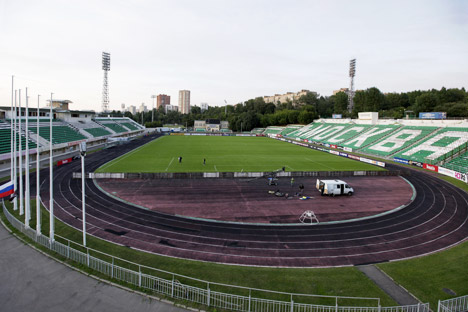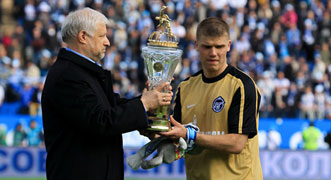Torpedo Stadium: A living history of Soviet soccer

Renovation will open a new chapter in the history of Streltsov Stadium. For the fans, however, this place will always be linked with the one man who was and remains a legend of Soviet soccer, Eduard Streltsov. Source: Anton Denisov / RIA Novosti
Torpedo Stadium—Moscow’s oldest—will soon be closed for renovation. This field, which has been owned by businessman Mikhail Prokhorov’s ONEXIM Group since 2007, is to be transformed into a modern sports complex where, in addition to a covered stadium, there are plans to build children’s sports schools and a museum of Russian soccer.
The building may not turn out to be as big as the Barclays Center in Brooklyn (which the Russian billionaire built for his NBA team, the Brooklyn Nets), but Torpedo fans have already expressed their concerns about the new building. The original plan was to completely demolish the stadium and develop the site as exclusive housing; however, when thousands of supporters signed a petition against the demolition of the stadium, the owners decided to preserve the sports facility.
Torpedo Stadium is unique, in a way. There are hardly any top-level spectacles here, as the home team plays in the second soccer division. Moreover, since August 2013, the Torpedo team has had to move: The club began playing its home games in the Moscow suburb of Ramenskoye, due to high rent.
Meanwhile, the stadium on Vostochnaya Street has become a favorite training ground for the Russian national soccer team, and, in August, the two best American football teams in Russia—Black Storm and the Moscow Patriots—played each other on the local field.
The Streltsov Torpedo Stadium is not located in the most picturesque of areas: Factory chimneys and brick walls stand alongside typical dismal Soviet-era buildings. It was here that, in 1924, the workers of the ZIL car factory started the Torpedo club.
Torpedo has always been a local soccer team. The car makers were nowhere near as popular as Spartak, which enjoyed national fame, and the black-and-whites could not boast of government patronage, as Dynamo could. In some ways, this is why the residents of Moscow’s Avtozavodsky District are so devoted to their club, despite the fact that, in the 2000s, the team did not experience the best of times.
Problems with finance mean the club has had to rely on young players it has developed itself, and Torpedo has not been able to get back into the Premier League for the last seven years. In a world of multi-million-dollar soccer transfers, Torpedo looks like a dinosaur that has somehow managed to survive.
Torpedo Stadium has never known the glory of Luzhniki, which served as the main stadium of the 1980 Olympics and the venue for the 2008 Champions League final. The field on Vostochnaya Street has never been Moscow’s main stadium, but, for Torpedo supporters, it is a shrine. This is where Eduard Streltsov—probably the best soccer players in Soviet history, if we leave aside the great Dynamo goalkeeper Lev Yashin—played and caught fans’ imagination.
Streltsov’s story is like a Hollywood film. At the age of 16, the wunderkind from a working-class suburb of Moscow became Torpedo’s main forward; at 17, he made a triumphant debut for the Soviet national team, scoring a hat trick in his first two games; at 18, he was the top goal-scorer in the Soviet league. Tall and strong, and with a broad grin, the young man caught everyone’s attention, on the field and off it.
His contemporaries recall that Streltsov played almost like a genius: His faultless technique, combined with his superb ability to read the game, enabled him to pull off real masterpieces of soccer, time and again. In 1956, the 19-year-old Streltsov was the key player on the Soviet team at the Melbourne Olympics, where the Soviet soccer players won gold for the first time in team history.
“He seemed to have the ball on a lead, and his ball control could get him past two or three defenders,” said defender Vladimir Ponomarev, Streltsov’s teammate on the Soviet national team, in an interview with Sovetsky Sport. “He had an exceptional soccer mind. He could anticipate and work out how the attack would develop, like a computer—several moves ahead, automatically, in an instant.”
The 1958 world championship should have been a golden moment for the Russian king of soccer, but Streltsov did not get to meet the other king of soccer—Brazil’s Pele—on the Swedish field. On June 15, while the Soviet team was losing 2-0 to Brazil, Streltsov was being interrogated by investigators at Moscow’s Butyrka prison. He had been arrested on May 27, on suspicion of rape during a party at a dacha not far from the Tarasovka sports center, where the Soviet team was preparing for the tournament. Streltsov was sentenced to 12 years in prison.
Arguments about how just the court’s decision was continue to this day. Some say Streltsov’s imprisonment was revenge by the KGB for his refusal to transfer to the Dynamo club, which was under the control of the special services; others link the sportsman’s drama to his refusal to marry the daughter of the iron lady of the Soviet government, the influential Yekaterina Furtseva. Doubt has been cast on many of the circumstances of that fateful night. It is likely that the truth of this story will never be known, but, in spite of everything, Streltsov will always be an idol to Torpedo fans.
Streltsov was given early release in 1963, and, after another two years, he was allowed to return to top-level soccer. At the age of 28, Streltsov took to the field again in a black-and-white Torpedo uniform. Even after six years in prison, there was no getting away from his talent: The powerful forward again became the leader of the Torpedo front line, taking his team to the championship in 1965.
The secret of Streltsov’s popularity was not just that he played like a genius. Supporters saw him as one of their own: While he was a professional sportsman, he continued to work at the factory and live in an ordinary apartment not far from the stadium. After Streltsov’s death (he died from lung cancer in 1990), officials decided to put up a monument to the soccer player by the entrance to the field; since 1997, the stadium itself has borne his name.
Renovation will open a new chapter in the history of Streltsov Stadium. Only time will tell to what extent it will preserve its inimitable atmosphere. For the fans, however, this place will always be linked with the one man who was and remains a legend of Soviet soccer.
All rights reserved by Rossiyskaya Gazeta.
Subscribe
to our newsletter!
Get the week's best stories straight to your inbox



